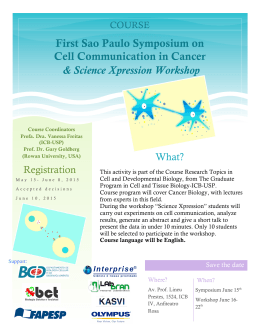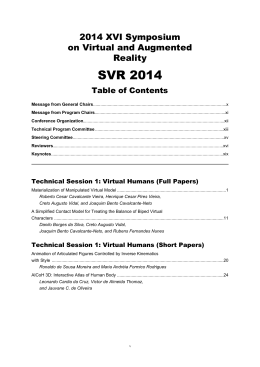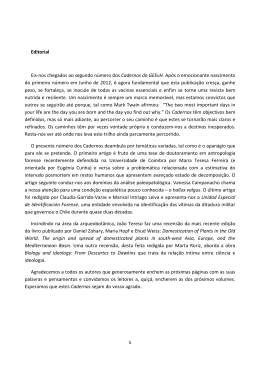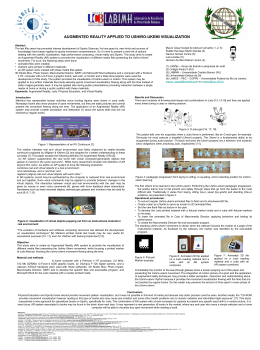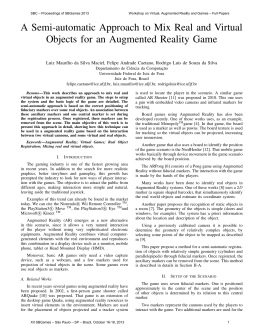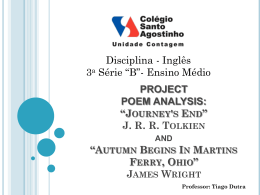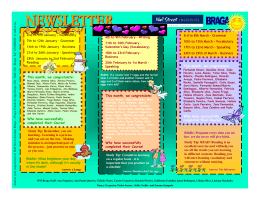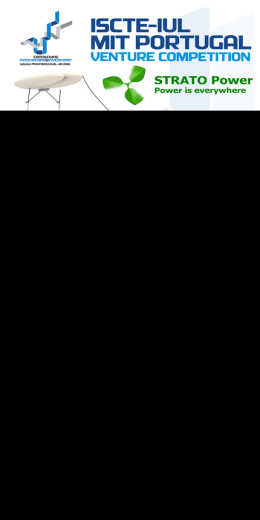CADERNOS 19 ANA REGINA MIZRAHY CUPERSCHMID , REGINA COELI RUSCHEL AND MÁRCIA REGINA DE FREITAS Technologies that support Augmented Reality applied to Architecture and Construction ANA REGINA MIZRAHY CUPERSCHMID , REGINA COELI RUSCHEL AND MÁRCIA REGINA DE FREITAS 48 Technologies that support Augmented Reality applied in Architecture and Construction Ana Regina Mizrahy Cuperschmid is Architect and Urban Planner (UFV); Specialist in Web Publishing (Langara College - Vancouver, Canada); Graduate Studies in Project Management in Information Technology (IBTA); Master’s Degree in Arts (IA-UNICAMP); currently doing a PhD in Architecture, Technology and Cities (FEC-UNICAMP). [email protected] Marcia Regina de Freitas is Civil engineer, PhD from POLI/USP, doing postdoctoral work at UNICAMP developing research involving Augmented Reality in construction and also interested in subjects related to the application of new technologies in construction processes. [email protected] Regina Coeli Ruschel is Civil Engineer, Faculty member and PhD from UNICAMP. Professor for courses in Civil Engineering and Architecture and Urbanism at UNICAMP. Coordinates the research group on Information Modeling and Digital Collaboration at FEC-UNICAMP. [email protected] CADERNOS 19 ANA REGINA MIZRAHY CUPERSCHMID , REGINA COELI RUSCHEL AND MÁRCIA REGINA DE FREITAS 49 Technologies that support Augmented Reality applied in Architecture and Construction ABSTRACT The use of Augmented Reality (AR) in architectural and construction applications has been studied and explored to find ways of using it in relation to the experience being sought after. This technology makes it possible to experience sensations and anticipate future events in environments that are still in the project phase, serving as a facilitative instrument during the planning, design and construction stages, all the way through to building maintenance. An article by Freitas and Ruschel (2010) evaluates AR and describes situations for using this technology in Brazil and around the world. In corroboration, this article seeks to explore different interaction techniques, display devices and tracking technologies used in applying AR to AEC (Architecture, Engineering and Construction). The article introduces the technologies that support AR and provides a brief overview of ongoing research and possible uses of AR in the market. It examines the possibilities offered by these technologies and furnishes technical concepts about AR systems. The goal, in addition to presenting AR interaction, tracking and display technologies within the realm of AEC, is to exemplify their practical use in these different fields. Keywords: Augmented Reality; Technologies; Architecture; Construction. CADERNOS 19 ANA REGINA MIZRAHY CUPERSCHMID , REGINA COELI RUSCHEL AND MÁRCIA REGINA DE FREITAS 50 Technologies that support Augmented Reality applied in Architecture and Construction Introduction I n Architecture and Construction, the use of Augmented Reality is still considered rather limited, despite the positive contributions it could make to the process of developing projects in this field. By enabling prior visualizations of events that have not yet taken place, AR is an interesting technology for the sector. Its use in this field is still primarily focused on marketing tools, by creating three-dimensional visualizations that allow customers to see a customized version of what they may choose to purchase. Other applications have already been foreseen and suggested, however, the need exists to understand the technology, the necessary equipment as per the goal of each application, the processes for developing 3D models, the ways in which virtual elements can be overlaid on the real world – in short, to understand what needs to be done to get the most out of AR for AEC. In AR environments, it is possible to interact with virtual objects in a number of ways. This article, therefore, will explore the interaction methods and uses related to architecture and construction, along with different application examples. Following this, it will discuss AR display technologies linked to devices such as Head-Mounted Displays (HMDs), mobile devices and projectors. Tracking techniques aimed at overlaying the image from the real world in a powerful and accurate way will also be addressed. 1. Interaction Techniques used in AR Applications With regard to interaction techniques employed in AR environments, Zorzal et al. (2009) claims that no consensus exists on how they should be applied. In 2005, however, Broll et al. classified the interaction techniques that could be applied in these environments, as: • Spatial interaction; • Command-based interaction; • Virtual control interaction; • Physical control interaction. The differences between the ways of interacting with virtual elements can be seen when examining the equipment involved and/or needed to allow access to the content, how data entry for interpretation by the machine occurs and the insertion of virtual information in the physical environment. In spatial interaction, the manipulation of the spatial properties of physical objects generally takes place through tangible interfaces (discussed in section 1d) which permit interaction via real objects in the location. In command-based interaction, data CADERNOS 19 ANA REGINA MIZRAHY CUPERSCHMID , REGINA COELI RUSCHEL AND MÁRCIA REGINA DE FREITAS 51 Technologies that support Augmented Reality applied in Architecture and Construction entry takes place through the tracking of symbolic gestures (for example: of the hands) or some other form of control, such as the voice, which represent instructions to be interpreted. Virtual control interaction is the result of manipulating three-dimensional graphic symbols presented to the user and that allow communication with the machine. In physical control interaction, this human-machine communication occurs through physical tools or control panels that permit access to both the physical environment and the virtual objects in the environment. Since no general consensus exists regarding the classification of interaction techniques, there are variants of this idea, all for the purpose of defining the forms of relationship between the user and the computer. Kelner and Teichrieb (2008) present the following classification of specific AR interaction techniques: Gesture Based Interfaces, Walking, Gesture Recognition, Pen Stroke and Tangible Interfaces. The possible uses of these techniques, according to the technology currently available, are described below. 1.1. Gesture Based Interfaces Gesture Based Interfaces respond to the gesticulations of the user, in such a way that predefined movements unleash certain responses from the system. According to Kelner and Teichrieb (2008), in this type of interaction the user is generally outfitted with a wearable computer and/or a glove to interact with the application. The interaction occurs through performing different predefined gestures to conduct tasks, such as opening and closing one’s hand. The gestures are identified by the use of a glove, which detects different levels of pressure for all the fingers, and a tracker. The combination of the activation of sensors from one or more fingers is configured into a gesture, controlling some aspect of the application. In the research field, Wang (2007) describes the conceptual system, ARUDesigner, designed for displaying and simulating an AR system using intelligent agents. It contains a combination of AR concepts and intelligent agents for the development of a collaborative tool for use in urban design projects. The main idea behind this conceptual system is to allow designers to interactively manipulate objects in a given urban area and access the effects in the intended environment, through a simulation with intelligent agents. The primary goal of ARUDesigner is to reduce interpretation obstacles between members of design teams, by providing visual information to improve the group’s efficiency and productivity. Designers are to sit around a table from where they’ll see the superimposed urban design via HMDs, as shown in Figure 1. They will be able to select and move virtual objects using gloves, since the grasp and release movement will be recognized by the system. CADERNOS 19 ANA REGINA MIZRAHY CUPERSCHMID , REGINA COELI RUSCHEL AND MÁRCIA REGINA DE FREITAS 52 Technologies that support Augmented Reality applied in Architecture and Construction FIGURE 1 Conceptual arrangement and use of the ARUDesigner system. Source: Wang, 2007, p. 562; Wang, Gu, Marchant, 2008, p. 542 On a commercial level, gloves are being used by the company D’strict (2012) for architectural presentations. The solution is called Hyper Presentation and uses gesture-based AR. The system uses a pair of gloves with sensors which are connected to digital content, allowing a presenter to manipulate the virtual model of a building by moving his hands. When the user wears a pair of gloves and conducts a presentation, a camera detects the movement and transmits the information via wireless which, in turn, is processed in order to recognize the gestures that are associated with predetermined actions. Figure 3 shows a drawing of how the system works. FIGURA 2 Drawing of how the Hyper Presentation works Source: D’STRICT, 2012, http://global.dstrict. com/hyperpresentation CADERNOS 19 ANA REGINA MIZRAHY CUPERSCHMID , REGINA COELI RUSCHEL AND MÁRCIA REGINA DE FREITAS 53 Technologies that support Augmented Reality applied in Architecture and Construction The technique of Gesture Based Interfaces is appropriate for presentations and discussions of projects, whether architectural or urban design. On such occasions, participants are able to interact and manipulate the presented models in a more natural way, through gestures. In addition, the ease of display and interpretation provided by the technique results in a better understanding of the proposals and, as a result, discussions about the project are more productive. 1.2. Mobile Augmented Reality System The walking technique, described by Kelner and Teichrieb (2008), makes it possible to walk in a virtual environment. For this purpose, a set of wearable computers can be used with head-mounted displays, trackers and GPS (Global Positioning System), as well as current mobile devices such as Tablets and Smartphones. The fact that computers have become more powerful and smaller in size permits new mobile applications through a combination of technologies, such as global tracking, wireless communication, location and service-based communication and the use of outfits, all of which have become feasible, enabling these applications to be used by anyone, in any place (Höllerer; Feiner, 2004). Users “wear” a computer and employ a display device, such as a helmet or HMD (see-through HMD), allowing them to move freely and be correctly located through GPS technology, which makes the use of mobile AR systems possible (Thomas; Piekarski; Gunther, 1999). Figure 3 shows a breakdown of the basic equipment used for these types of AR applications, according to Behzadan, Timm and Kamat (2008). FIGURE 3 Basic hardware components of a mobile AR system. Source: BEHZADAN; TIMM; KAMAT, 2008, pp. 91 and 94. CADERNOS 19 ANA REGINA MIZRAHY CUPERSCHMID , REGINA COELI RUSCHEL AND MÁRCIA REGINA DE FREITAS 54 Technologies that support Augmented Reality applied in Architecture and Construction This form of using AR has been studied for some time, as seen in the research by Thomas, Piekarski and Gunther (1999), which describes one such system developed at the University of South Australia to help people visualize architectural projects in their outdoor physical context. When an observer uses an HMD, they see an overlay of drawings in their field of vision. With the use of GPS and a digital compass, the user becomes skilled at accurately recording contour lines of the building, while observing the construction. The green lines represent a proposed reform and the user is free to walk around the work and evaluate the proposed form and size, enabling the general context of the reform to be visualized. Other examples of using equipment for AR mobile applications can be found in articles by authors such as Höllerer and Feiner (2004), Guo et al. (2008), Behzadan and Kamat, (2005), Behzadan and Kamat (2009) and others who have addressed the subject. The emergence of tablets and smartphones, equipped with wireless connections and GPS, has made it possible to use mobile AR in a simpler way. An example of this was developed by the authors through using the Junaio application (www.junaio.com) to simulate the marking of an environment that would be undergoing reforms. The georeferenced location of the points was determined beforehand, and in each location a tag was placed with information about the task to be performed. Figure 4 shows a recent test done for simulating the reform in the Department of Architecture and Construction (IE). Figure 4a shows the device that was used, an iPad 3, displaying the AR information layer that was inserted into the environment for simulating the tasks that would be performed (painting, building, demolishing) and Figure 4b presents a specification detail in the form of an existing link on each tag. FIGURE 4 Test for using the Junaio application for a virtual AR information layer simulation, describing reform tasks in a real environment - Source: from the authors, 2012 A B a - iPad3 screen showing the tags with the reform tasks. b - Link detail on the tag “Paint” with specific information about this task. CADERNOS 19 ANA REGINA MIZRAHY CUPERSCHMID , REGINA COELI RUSCHEL AND MÁRCIA REGINA DE FREITAS 55 Technologies that support Augmented Reality applied in Architecture and Construction This technique can be used in mobile AR systems at different times during the design process according to the level of detail of the virtual model. If the model only contains the volume of the building, it will serve for a study of volume and implementation. Thus, during the implementation study phase, the 3D model of the building to be constructed can be positioned in real scale in the environment. This makes it possible to evaluate the impact of the future building, in terms of volume and interaction with the surrounding buildings in the real environment. Once the design has been completed and a 3D model has been created, a mobile AR system can be used in sales marketing, enabling customers to view and/or interact with the still virtual building in physical space. Mobile AR systems, with the use of georeferencing, when utilized with tags containing descriptive/explanatory text, can specify certain Points of Interest (POIs). POIs can contain information about the findings of the Post-Occupancy Evaluation (POE), data for reforms or suggestions in the construction site - such as the arrangement of elements in the space. An interesting application for mobile AR systems is the simulation of x-ray vision in already completed buildings. Using this procedure enables the embedded networks (electrical, plumbing, air conditioning) to be viewed, virtually, through the masonry. This can be done for a final check before using the building or during its use/operation for detecting likely abnormalities or for maintenance purposes in accordance with the design as built. 1.3. Remote Control Interaction This technique was described by Kelner and Teichrieb (2008) as Pen-Stroke Gesture Recognition, since it is based on recognizing the movements of a pen on a touchscreen. As the forms of interaction, as well as touchscreens, have evolved, research can now be found which uses video game remote controls, such as the Nintendo Wii console. Virtual Innovation in Construction (VIC) is a project aimed at developing a methodology, VIC-MET, supported by information and communication technology, and developed by Christiansson et al. (2011). The project seeks to involve the participation of end users of buildings at each stage of the design process. The method endeavors to capture and express user needs as well as the requirements of buildings and their functionalities. This method provides certain tools for obtaining necessary knowledge in a process involving end users, and thereby incorporates the needs of users in buildings. The virtual environment includes CAVE (Cave Automatic Virtual Environment) and Panorama, a game solution based on Nintendo Wii and a virtual world in Second Life. This system has been used more in Virtual Reality, providing remote control of the interaction with synthetic environments. In Augmented Reality, the use of these devices is not a solution that has been explored much yet. However, one CADERNOS 19 ANA REGINA MIZRAHY CUPERSCHMID , REGINA COELI RUSCHEL AND MÁRCIA REGINA DE FREITAS 56 Technologies that support Augmented Reality applied in Architecture and Construction can foresee the use of remote controls to manipulate virtual models and, by means of AR glasses, to display the mix of the worlds. Thus, it will be possible to make changes in virtual models and display them in real time. 1.4. Tangible Interfaces The technique of Tangible Interfaces enables virtual objects to be manipulated using physical objects. In the Tangible User Interface (TUI), physical objects are used to manipulate digital data. The TUI metaphor can also be applied to AR interfaces, known as Tangible AR (Haller; Billinghurst; Thomas, 2007). Tangible interfaces are touch-based in order to operate them. In this situation, virtual objects are connected with real objects, for example, the movement of boxes on a table causes the movement of objects in virtual space (Hanzl, 2007). In Tangible AR, the physical objects and interactions are as important as the virtual image and provide an intuitive way to interact with AR interfaces. Figure 5 is an example of a Tangible AR. Here the user is using a Head-Mounted Display which has a camera attached to the front of it. When the user looks at an actual page from the book through the device, he sees a virtual object popping out from it. Because the yacht object is tied to the physical page of the book, the user can move and rotate it by simply moving the book. With Tangible AR, virtual elements can be linked with tangible interfaces for manipulation similar to that of real objects; thus, physical objects are used to interact with virtual content (Haller; Billinghurst; Thomas, 2007; Schnabel, 2009). A Tangible AR interface provides the spatial registration and presents virtual objects anywhere in the physical environment, while allowing users to interact with this virtual content, using the same techniques that they would use with a real physical object (Billinghurst, Kato; Poupyrev, 2008). Therefore, Tangible AR interfaces provide intuitive and effective manipulation of virtual objects by taking advantage of the immediacy and familiarity of common physical objects. This direct manipulation reduces the cognitive load and decreases the learning curve for using the interface (Belcher; Johnson, 2008). FIGURE 5 Example of Tangible Augmented Reality Source: Lee, Kim and Billinghurst, 2007, p. 262 CADERNOS 19 ANA REGINA MIZRAHY CUPERSCHMID , REGINA COELI RUSCHEL AND MÁRCIA REGINA DE FREITAS 57 Technologies that support Augmented Reality applied in Architecture and Construction In terms of the physical object used to interact with the Tangible AR system, some points should be observed, such as appearance, physical properties, semantic representations, spatial relations and the ability to help keep the focus of attention not on the system, but on the project that is being developed (Kato et al. 2000). The MR Tent project, developed by Wagner et al. (2009), seeks to use technologies that enable participation combined with methods for preparing and equipping a heterogeneous group of participants to create a vision of an urban project. The object of study is located in the city of Pontoise, 40 km from Paris, France. The site is 13 hectares in size and has housed a police department since 2005, in addition to being used as a training ground for fire brigades. The goal is to build 2,000 housing units, a commercial area and a convention and exhibition center. The technical infrastructure is arranged in a tent specifically created for the design workshops. The way in which the space, the materials and different types of content affect participation and the discussion of urban issues is observed and talked about. To decide the type and locations of the future buildings in the project, participants placed colored objects on the map. These objects were associated with virtual elements through reading the barcode on the chosen card (Figure 6). The major advantage of using this technology was that it gathered people around the table and provided them with tools that are easy to learn and handle in an interactive manner, so that they could quickly develop an effective means to work together. FIGURE 6 Co-construction through gesticulation and conversation Source: WAGNER et al., 2009, p. 189 CADERNOS 19 ANA REGINA MIZRAHY CUPERSCHMID , REGINA COELI RUSCHEL AND MÁRCIA REGINA DE FREITAS 58 Technologies that support Augmented Reality applied in Architecture and Construction In Tangible AR applications that use direct display devices (such as a HeadMounted Display), the virtual object is displayed in the same position and orientation as its physical counterpart, creating a direct mapping of its properties such as position and orientation (Haller; Billinghurst; Thomas, 2007). Thus, with the use of direct display devices, there is no disconnection between the area in which activities are being developed and the display area. This technique can be used during the project creation phase. A research project being developed by the authors focuses on the use of AR in Participatory Projects and employs this technique to design a recreational area in a Social Interest Housing Project. Figure 7 shows images that act as markers being manipulated by a user. The images are superimposed by the virtual model of a skate park and children’s park, respectively. Tangible AR can also be used as a marketing tool, allowing customers to directly visualize and manipulate a virtual building, without requiring extensive computer knowledge. FIGURE 7 Participatory Project using Tangible AR Source: from the authors, 2012 2. Display Devices Various display devices have been used for AR. Each device has its advantages and disadvantages from the perspective of collaboration support. Kiyokawa (2007) highlights the following display devices: Volumetric Display, IllusionHole, Virtual Showcase, Optical STHMD, Video STHMD, Projective HMD, Handheld video ST, Projection-based (Kiyokawa, 2007). Bimber and Raskar (2005) categorize display devices as head-attached displays, hand-held displays and spatial devices. This text uses the nomenclature of Smartphones and Tablets for handheld devices, since they are the mobile devices that are most commonly used. CADERNOS 19 ANA REGINA MIZRAHY CUPERSCHMID , REGINA COELI RUSCHEL AND MÁRCIA REGINA DE FREITAS 59 Technologies that support Augmented Reality applied in Architecture and Construction 2.1. Head-attached displays There are three different types, depending on the technology: head-mounted displays, retina display devices and head-mounted projectors. According to Bimber and Raskar (2005), head-mounted displays are the mostused display devices for applications, since they use some type of head-attached display. HMDs are part of a class of immersive devices used in AR, characterized by the ability to see through the display medium directly into the world surrounding the observer, thereby achieving the maximal possible extent of presence and level of image quality. Milgram et al. (1995) point out that such optical devices need accurate low-latency head tracking. They also emphasize the importance of precise calibration and viewpoint matching, adequate field of view and user comfort while wearing the device. There are two different head-mounted display technologies: optical-based and video-based (MACCHIARELLA; LIU; VINCENZI, 2009; SCHMORROW et al. 2009; BIMBER; RASKAR, 2005). Optical-based systems usually use devices comprised of lenses that allow users to see the real world, with the virtual world projected onto the lenses, which are positioned in front of the eyes. The translucent lenses enable users to look directly through the lens to view the real world. Thus, users see the virtual world superimposed on the physical one. Video-based systems use video cameras that provide users with a view of the real world. The video from these cameras is combined with virtual images, generating a scene that blends the real world and the virtual. The result can be viewed through the head-mounted display that provides a closed vision through monitors in front of the eyes of the users. Head-attached displays require users to use a visualization system on their head. Schmorrow et al. (2009) and Bimber and Raskar (2005) introduce an exotic form of head-attached display, a retinal scanning device that uses low-level laser to project lights directly onto the retina of the user. Among head-attached displays, there are also head-mounted projectors, which use miniature projectors, or miniature LCD panels, with backlight and images projected on the surface of the real environment. Google has developed Project Glass1 which focuses on using Augmented Reality with more modern, discreet and lighter glasses than those currently available in the market. The prototype of the device has a display and a camera to capture images. Figure 8 shows an image released by the company to promote the product. 1. Available at: <https://plus.google.com/111626127367496192147/posts> CADERNOS 19 ANA REGINA MIZRAHY CUPERSCHMID , REGINA COELI RUSCHEL AND MÁRCIA REGINA DE FREITAS 60 Technologies that support Augmented Reality applied in Architecture and Construction FIGURE 8 Prototype of the Augmented Reality glasses by Google. Source: Google, 2012, https://plus.google. com/111626127367 496192147/posts. Broll et al. (2004) developed the ARTHUR system, an AR system that provides an environment and tools which enhances collaboration between experts working on architectural designs. ARTHUR tries to preserve natural communication and collaboration between users. It uses wireless optical devices, such as Head Mounted Displays, which permit natural 3D vision. Virtual objects are displayed through stereoscopic visualization to integrate them into the physical environment. The application scenario for the system in an urban context of the city of London, England, served as a test for urban and architectural design. A model of London is displayed on the top of a round table, allowing users to find a suitable place for a given building. This includes the possibility of removing existing buildings to create a suitable space for the new building. Users can insert the new building (which was created outside the ARTHUR environment) and manipulate it through objects that act as markers. ARTHUR, according to the authors, provides designers with a new tool that connects 3D models to interaction mechanisms similar to those of the real world. For architectural design, the use of head-attached displays in AR systems enables great freedom of movement for those involved and provides participants with an individualized and direct visualization before their eyes. As a result, each user has his or her hands free to manipulate the virtual models. CADERNOS 19 ANA REGINA MIZRAHY CUPERSCHMID , REGINA COELI RUSCHEL AND MÁRCIA REGINA DE FREITAS 61 Technologies that support Augmented Reality applied in Architecture and Construction 2.2. Smartphones and Tablets With the current availability of mobile devices, such as smartphones and tablets, research has been conducted making use of these mediums to develop AR applications, enhancing the versatility of the use of this technology (Rösler, 2009), which may suggest an increased range of possible applications. Mobile devices combine, in one single apparatus, a processor, memory, display, interaction technology, GPS and a digital compass. In these systems, integrated cameras capture the video of the real environment and process the mix of the environments before displaying them (Bimber, Raskar, 2005). Shimmer is a program for iPad/iPhones which enables users to use COLLADA (DAE), Wavefront (OBJ), 3D Studio (3DS) and DirectX (X) models in Augmented Reality. The system uses banknotes as markers. It currently accepts one, five and ten dollar bills (U.S.) and some bills such as five Euros, among others from different Asian countries. The user can upload their own models that are in the Dropbox application or email servers. The model can take time to load depending on the wireless connection available. For the test presented in the following text, a building model was developed in REVIT Architecture (Autodesk), exported to FBX file format, imported into 3D Max and exported to COLLADA to be placed in the Dropbox. FIGURE 9 Model for constructing a building viewed using the Shimmer application for iPad Source: from the authors (2012) CADERNOS 19 ANA REGINA MIZRAHY CUPERSCHMID , REGINA COELI RUSCHEL AND MÁRCIA REGINA DE FREITAS 62 Technologies that support Augmented Reality applied in Architecture and Construction Some development companies such as Metaio (www.metaio.com), String (www.poweredbystring.com) and Qualcomm (https://ar.qualcomm.at) provide Software Development Kits (SDKs) for AR in smartphones and tablets that enable customized applications to be developed. These SDKs broaden the use of this equipment for AR, since they permit a wide range of applicability. Applications for smartphones and tablets such as Junaio, Layar (www.layar. com) and Wikitude (www.wikitude.com) serve as AR browsers. These systems possess documentation from Application Programming Interface (API) that enables rapid interaction with programming, thereby facilitating the implementation of activities with AR. 2.3. Spatial Devices Spatial devices, in contrast with the previous devices, integrate the virtual element with the real environment so that users do not need to use (wear) equipment, since it is attached to them. According to Bimber and Raskar (2005), this category includes: spatial optical see-through displays, projector-based spatial displays and screen-based video see-through displays. Spatial optical seethrough displays generate images that are aligned with the physical environment. They use an optical spatial combination, such as flat or curved mirrors, transparent screens or optical holograms. Projector-based spatial displays use front projection to project images directly onto the surfaces of physical objects. Individual, stereo or multiple static projectors are used for this technique. Screen-based video see-through display systems use a camera to capture the real world, process information and display the mixed images on a normal monitor or project the composite scene on a flat screen (such as a computer monitor or data projector screen). This form of using AR entails a low level of immersion, which in such environments is commonly linked to the field of view of the observer. In this case, the field of view is limited and restricted to the size of the monitor or screen. This is a common technique for using AR because it does not require expensive equipment, only a computer, web camera and monitor, thus offering the best cost-benefit ratio. 3. Tracking Correct and consistent tracking between virtual objects and the real environment is one of the most important tasks of AR. Tracking and recording are currently the biggest challenges in AR research. In regard to the method used to calculate where the virtual object and form of tracking will be added, Bimber and Raskar (2005) highlight the use of markers, GPS technology and infrared sensors. Efforts have been made to improve the performance, accuracy and cost of tracking systems. These systems seek to continuously determine the position of the user or actual object to be used for overlaying the virtual on the physical environment. According to Kirner and Siscoutto (2008), the purpose of tracking is to identify the position of the hand, the head, the user himself or CADERNOS 19 ANA REGINA MIZRAHY CUPERSCHMID , REGINA COELI RUSCHEL AND MÁRCIA REGINA DE FREITAS 63 Technologies that support Augmented Reality applied in Architecture and Construction an object attached to him. It is possible, therefore, for the user to control the positioning of virtual objects and, as a result, he can move around in order to take hold of them, move them or let them go, for example. Optical tracking is very popular. With this type of tracking, the position and orientation of markers can be quickly obtained, by using a simple web camera, and thus represents a low-cost option (Bimber; Raskar, 2005). By means of a marker, it is possible to alter certain attributes, such as the visibility, translation, rotation and scale of the virtual objects. Through a specific script it is also possible to associate a movement of the marker with a certain part of a specific animation (Santin; Kirner, 2008). In Tangible AR systems, the use of markers is the most common method of interaction. Thus, by means of optical tracking, it is not necessary in Tangible AR systems to use devices such as gloves with sensors, or wearable computers, since users interact with the interface freely using their hands. This results in users feeling free to manipulate markers that are associated with virtual objects. A marker is an image with a certain visual pattern recognized by the AR system, as shown in Figure 10, which serves to orient and position virtual objects in the environment. Thus, the marker becomes the means of interaction between the user and the system, enabling the user to manipulate the marker and, in so doing, perform actions on virtual objects displayed in the environment. Markers make it possible to accurately locate points in real space and their association with the virtual object. There are two types of markers: fiducial and natural. A fiducial marker has a certain graphic black and white pattern, while a natural marker can be a photographic image or physical object. FIGURE 10 Example of a fiducial marker Source: ARToolKit Special devices for displaying AR with markers are commonly used, such as head-mounted displays, mobile devices (for example, smartphones and tablets), computer monitors and projections on screens. Figure 11 shows the use of markers and, as a display device, the image projected on a screen (technique of screen-based video see-through display). CADERNOS 19 ANA REGINA MIZRAHY CUPERSCHMID , REGINA COELI RUSCHEL AND MÁRCIA REGINA DE FREITAS 64 Technologies that support Augmented Reality applied in Architecture and Construction FIGURE 11 Use of markers and, as a display device, the image projected on a screen Source: from the authors (2011) According to Bimber and Raskcar (2005), markerless tracking solutions are the most challenging, as well as the most promising, for future AR applications. It is difficult to achieve high quality tracking in large environments, such as outdoor environments, even with GPS technology. When there is no 2D element that makes the association of the virtual element with the real, it becomes necessary to obtain the actual coordinates of the user in the physical world, which enables the latter to walk through the site visualizing information related to the environment, for example: locations of restaurants, shops, bars and other functionalities (Figure 12). The information is updated in real time, that is, it transmits the real view to the user during the walk according to their movements, by receiving a GPS signal, during the time an HMD is worn (Bonsor, 2009). FIGURE 12 Practical Use of AR in outdoor environment Source: BONSOR, 2009, http://computer. howstuffworks.com/ augmented-reality.htm CADERNOS 19 ANA REGINA MIZRAHY CUPERSCHMID , REGINA COELI RUSCHEL AND MÁRCIA REGINA DE FREITAS 65 Technologies that support Augmented Reality applied in Architecture and Construction An example that uses GPS from iPhones (Apple Inc.) to read latitude, longitude and elevation for obtaining the position data of equipment, corresponding to the X, Y and Z coordinates, is the system called MOOAR system (Multi-Object Oriented Augmented Reality system) (Chang; Tan, 2010). In addition to these coordinates, the iPhone digital compass and accelerometer are used to detect the orientation of the device. Figure 13 shows the coordinates detected by the GPS of the iPhone to obtain the 6 degrees of freedom, which is essential for enabling AR interaction in a mobile system. FIGURE 13 The 6 degrees of freedom (6DOF) of the iPhone Source: CHANG; TAN, 2010, p. 22 Currently, equipment for AR, which uses a GPS signal to track the user’s position, is quite reliably employed in outdoor locations. In indoor environments where the exact location of the user may not be reliably detected by the GPS signal (signal via satellite), it is more common to use markers, as already mentioned, but there are already technologies being developed to achieve the same result (Khoury; Kamat, 2009). The limitations in regard to tracking should be increasingly resolved as technologies are developed in order to provide users with greater accuracy and freedom. Considerations This article performed a review of the current state-of-the-art technologies used for Augmented Reality and their present and future application in Architecture, Engineering and Construction. AR is considered to be a technology that adjusts to the modernization process of construction methods involving areas of AEC. As illustrated in this paper, some studies have used AR, especially during the project design phase in AEC. However, it can contribute to all stages of construction, ranging from design to the operation and maintenance phases. For presenting the design proposals of a building, AR can effectively provide a better understanding, thus promoting discussion – whether within the design CADERNOS 19 ANA REGINA MIZRAHY CUPERSCHMID , REGINA COELI RUSCHEL AND MÁRCIA REGINA DE FREITAS 66 Technologies that support Augmented Reality applied in Architecture and Construction team or between the team and users, in cases involving their participation. In the sales phase of a building, AR can be geared toward marketing. During the operation and maintenance phase of a building, it is also possible to use AR to display POE data and simulate x-ray vision – for viewing embedded networks (electrical, plumbing, air conditioning). It’s worth noting that the tools for developing AR applications are constantly improving, according to the needs of developers and users. Among the tools already tested by the authors, these systems require a user-friendly interface for their use in AEC. Apart from that, more technical information is needed on treating virtual models (both in terms of the model’s vertices and treatment of the images used as textures). This is because the development of these applications demands knowledge of programming as well as modeling, beyond that normally required by professionals in this area. Much has already been developed, but with the evolution of the technology the use of AR can be further expanded. New possibilities are arising and, with them, new ways are created to interact with and manipulate virtual objects in these environments. There are currently several focuses of AR development in Brazil, not necessarily directed toward AEC. This article, however, presents experiments that have been conducted in the country, within the realm of academic research, which indicate progress in this field. Acknowledgments To Fapesp, for making possible the doctoral and post-doctoral research upon which this text was based. References Design in Europe Conferences - eCAADe, 26., 2008. Proceedings... Antwerp, Belgium. pp. 561-568. BEHZADAN, A.H.; KAMAT, V.R. Visualization of Construction Graphics in Outdoor Augmented Reality. In: WINTER SIMULATION CONFERENCE, 2005, Piscataway. Proceedings... Piscataway: Institute of Electrical and Electronics Engineers (IEEE) - M. E. Kuhl, N. M. Steiger, F. B. Armstrong, and J. A. Joines, eds, 2005. pp. 1914-1920. Available at: <http://pathfinder.engin.umich.edu>. Accessed on 5/10/2012. ______. Interactive Augmented Reality Visualization for Improved Damage Prevention and Maintenance of Underground Infrastructure. In: CONSTRUCTION RESEARCH CONGRESS, 2009, Seattle. Proceedings… Seattle: American Society of Civil Engineers, 2009. pp. 1214-1222. Available at: <http://pathfinder.engin. umich.edu>. Accessed on 5/20/2012. CADERNOS 19 ANA REGINA MIZRAHY CUPERSCHMID , REGINA COELI RUSCHEL AND MÁRCIA REGINA DE FREITAS 67 Technologies that support Augmented Reality applied in Architecture and Construction BEHZADAN, A.H.; TIMM, B.W.; KAMAT, V.R. General-Purpose Modular Hardware and Software Framework for Mobile Outdoor Augmented Reality Applications in Engineering. In: Advanced Engineering Informatics. Amsterdam, Vol. 22, No. 1, January 2008. pp. 90-105. Available at: <http://citeseerx.ist.psu.edu>. Accessed on 4/28/2010. BILLINGHURST, M.; KATO, H.; POUPYREV, I. Tangible augmented reality. In: SIGGRAPH ASIA 2008. International Conference on Computer Graphics and Interactive Techniques. ACM: New York, No. 7, 2008. Available at <http://portal.acm. org/>. Accessed on 10/3/2010. BIMBER, O; RASKAR, R. Spatial Augmented Reality: Merging Real and Virtual Worlds. Wellesley: A K Peters, Ltd., 2005, 369 p. Bonsor, K. How Augmented Reality Will Work. 2009. Available at: <http://computer.howstuffworks.com/augmented-reality.htm>. Accessed on 3/9/2012. BROLL, W. et al. ARTHUR: A Collaborative Augmented Environment for Architectural Design and Urban Planning. Journal of Virtual Reality and Broadcasting, Vol. 1, No. 1, pp. 1-10, 2004. ISSN 1860-2037. Available at: < http://www.cs.wpi. edu/~gogo/hive/papers/broll_JVRB2004.pdf >. Accessed on: 5/24/2011. BROLL W. et al. An Infrastructure for Realizing Custom-Tailored Augmented Reality User Interfaces. In: IEEE Transactions on Visualization and Computer Graphics, Vol. 11, No. 6, pp. 722-733, 2005. Available at: <http://ieeexplore.ieee. org/>. Accessed on: 8/9/2012. CHANG, W.; TAN, Q. Augmented Reality System Design and Scenario Study for Location-based Adaptive Mobile Learning. In: IEEE International Conference on Computational Science and Engineering, 13., Hong Kong, China. Proceedings… Hong Kong, December 2010, pp. 20 - 27. CHRISTIANSSON, P. et al. User participation in the building process. Journal of Information Technology in Construction, Vol. 16, pp. 309-334, 2011. ISSN 18744753. Available at: <http://www.itcon.org/2011/20>. Accessed on: 3/18/2011. D’STRICT. Hyper Presentation. http://global.dstrict.com/hyperpresentation/. Augmented Reality business presentation platform with full gesture sensing control, 2012. Accessed on: 6/10/2012. FREITAS, M. R.; RUSCHEL, R. C. Aplicação de realidade virtual e aumentada em arquitetura. Arquitetura revista, v.6: p. 127-135, 2010. GUO, Y. et al. Application of Augmented Reality GIS in Architecture. In: The International Archives of the Photogrammetry, Remote Sensing and Spatial Information Sciences, 21., 2008, Beijing. Technical Article… Beijing: ISPRS - International Society for Photogrammetry and Remote Sensing, 2008. Vol. XXXVII. pp. 331 – 336. Available at: <http://www.isprs.org>. Accessed on 4/14/2012. CADERNOS 19 ANA REGINA MIZRAHY CUPERSCHMID , REGINA COELI RUSCHEL AND MÁRCIA REGINA DE FREITAS 68 Technologies that support Augmented Reality applied in Architecture and Construction HANZL, M. Information technology as a tool for public participation in urban planning: a review of experiments and potentials. Design Studies, Vol. 28, No. 3, pp. 289-307, May 2007. Obtained via the SCIENCE DIRECT database Available at <http://www.sciencedirect.com>. Accessed on 9/9/2010. HALLER, M.; BILLINGHURST, M.; THOMAS, B. Emerging Technologies of Augmented Reality: Interfaces and Design. Idea Group Publishing, 2007. 415 ISBN 1-59904-066-2. HÖLLERER, T. H., FEINER, S. K., Mobile Augmented Reality. In: Telegeoinformatics: Location-Based Computing and Services. Technical Article... London: H. Karimi and A. Hammad editors/Taylor and Francis Books Ltd, 2004. pp. 1-39. Available at: <http://www.cs.ucsb.edu/>. Accessed on 4/20/2012. KATO, H. et al. Virtual object manipulation on a table-top AR environment. (ISAR 2000). Proceedings of the IEEE and ACM International Symposium on Augmented Reality, 2000. pp. 111-119. KELNER, J.; TEICHRIEB, V. Técnicas de Interação para Ambientes de Realidade Virtual e Aumentada. In: SISCOUTTO, R. e COSTA, R. (Ed.). Realidade Virtual e Aumentada: Uma Abordagem Tecnológica. João Pessoa - PB: Editora SBC – Sociedade Brasileira de Computação, 2008. p. 45-65. KIYOKAWA, K. Human Communication in Collaborative Augmented Reality Systems. In: HALLER, M.; BILLINGHURST, M.; THOMAS, B. Emerging Technologies of Augmented Reality: Interfaces and Design. Idea Group Publishing, 2007, Ch. XII, pp. 236-260. ISBN 1-59904-066-2. KIRNER, C.; SISCOUTTO, R. Fundamentos de Realidade Virtual e Aumentada. In: SISCOUTTO, R. e COSTA, R. (Ed.). Realidade Virtual e Aumentada: Uma Abordagem Tecnológica. João Pessoa - PB: Editora SBC – Sociedade Brasileira de Computação, 2008. p.1-20. KHOURY, H.; KAMAT, V. Evaluation of position tracking technologies for user localization in indoor construction environments. Automation in Construction, Amsterdam, Vol. 18, No. 4, 2009, pp. 444-457. LEE, G., KIM, G. and BILLINGHURST, M. Interaction Design for Tangible Augmented Reality Applications. In M. Haller, M. Billinghurst and B. Thomas (Ed.), Emerging Technologies of Augmented Reality: Interfaces and Design: pp. 261282. Hershey, PA: Idea Group. 2007. (Chapter of the book) MACCHIARELLA, N. D.; LIU, D. VINCENZI, D. A. Augmented Reality as a Means of Job Task Training in Aviation. In: VINCENZI, D. A. et al. Human factors in Simulation and Training. New York: 2009. pp. 201-228. ISBN 9781420072839. MILGRAM, P. et al. Augmented Reality: A Class of Displays on the Reality-Virtuality Continuum. Proceedings of the SPIE Conference on Telemanipulator and Telepresence Technologies, 1995. pp. 282-292. CADERNOS 19 ANA REGINA MIZRAHY CUPERSCHMID , REGINA COELI RUSCHEL E MÁRCIA REGINA DE FREITAS 69 Tecnologias que suportam Realidade Aumentada empregadas em Arquitetura e Construção Technologies that support Augmented Reality applied in Architecture and Construction RÖSLER, A. Augmented Reality Games on the iPhone. 36 p. Thesis (BA). Blekinge Institute of Technology, Karlskrona. 2009. SANTIN, R.; KIRNER, C. ARToolkit: Conceitos e Ferramenta de Autoria Colaborativa. In: SISCOUTTO, R. e COSTA, R. (Ed.). Realidade Virtual e Aumentada: Uma Abordagem Tecnológica. João Pessoa - PB: Editora SBC – Sociedade Brasileira de Computação, 2008. p.178-276. SCHMORROW, D. et al. Virtual Reality in the Training Environment. In: VINCENZI, D. A. et al. Human Factors in Simulation and Training. New York: 2009. pp. 201-228. ISBN 9781420072839. SCHNABEL, M. A. Framing Mixed Realities. In: WANG, X.; SCHNABEL, M. A (Ed.). Mixed Reality in Architecture, Design & Construction: Springer, 2009. Ch. 1, pp. 13-21. ISBN 978-1-4020-9087-5. THOMAS, B.; PIEKARSKI, W.; GUNTHER, B. Using Augmented Reality to Visualize Architecture Design in an Outdoor Environment. In: Design Computing on the Net: DCNET, 1999, Sidney. Technical Article... Sidney, 1999. 8 p. Available at: <http://citeseerx.ist.psu.edu>. Accessed on 5/3/2012. WAGNER, I. et al. Supporting community engagement in the city: urban planning in the MR-tent. Proceedings of the 4th International Conference on Communities and Technologies, 2009. University Park, PA, USA. ACM. pp. 185-194. WANG, X. Agent-based Augmented Reality System for Urban Design: Framework and Experimentation. In: CAADRIA 2007 - Proceedings of the International Conference on Computer Aided Architectural Design Research in Asia, 12. Nanjing (China). 2007. pp. 561-568. WANG, X.; GU, N.; MARCHANT, D. An Empirical Study on Designers’ Perceptions of Augmented Reality within an Architectural Firm. Electronic Journal of Information Technology in Construction ITcon, 13 (special issue), 2008, pp. 536-552. Available at: <http://www.itcon.org/2008/33>. Accessed on: 10/17/2011. ZORZAL, E.R. et al. Técnicas de Interação para Ambientes de Realidade Aumentada. In: Workshop de Realidade Virtual e Aumentada - WRVA 2010, 6, Santos - SP. Anais... Porto Alegre - RS : SBC, 6 p., 2010. CADERNOS 19
Download
